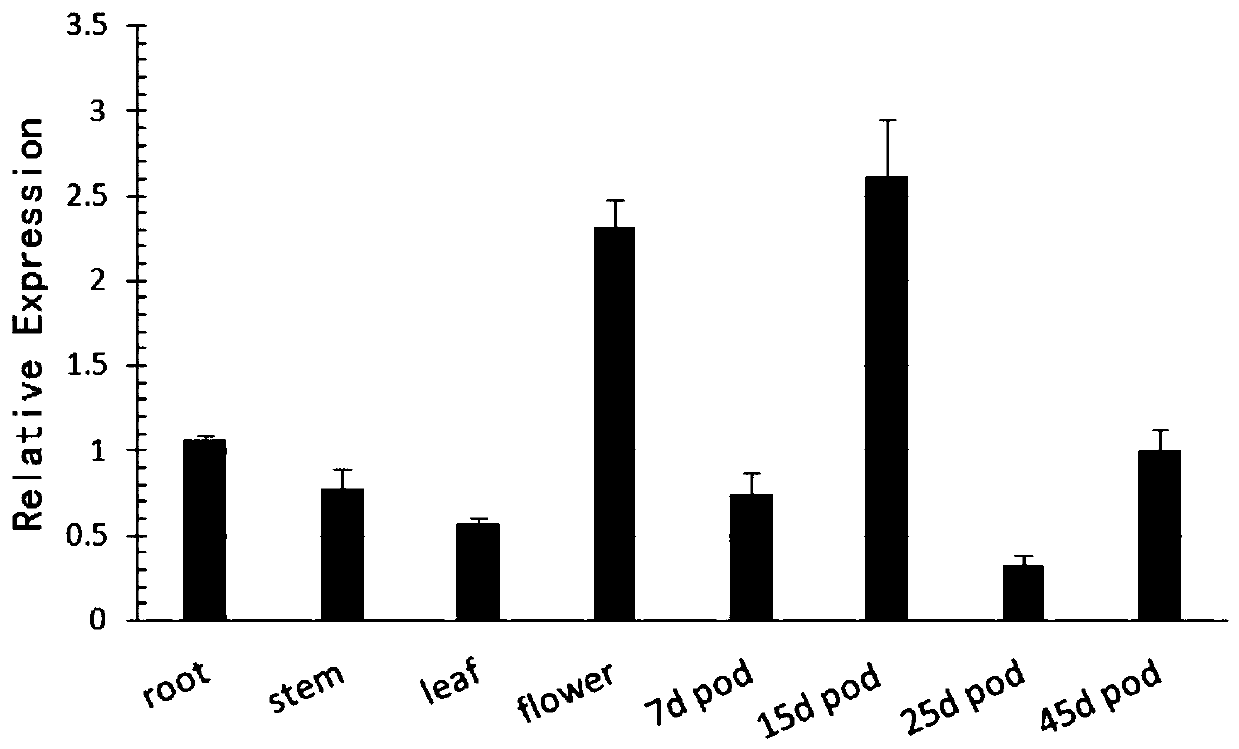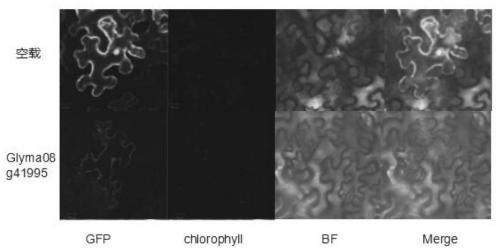Application of soybean NAC transcription factor family gene Glyma08g41995
A technology of transcription factor and family, which is applied in the application field of soybean NAC transcription factor family gene Glyma08g41995, and can solve the problem that the functions of NAC transcription factors are not completely the same
- Summary
- Abstract
- Description
- Claims
- Application Information
AI Technical Summary
Problems solved by technology
Method used
Image
Examples
Embodiment 1
[0032] Example 1 Cloning and identification of soybean Glyma08g41995 and its coding gene
[0033] Primers were designed according to the sequence information of Glyma08g41995 predicted on the phytozome website, and the flower cDNA of Willmas82 in full flowering stage was used as a template for PCR amplification.
[0034] Upstream primer Gm08g41995-F: ggatcttccagagatCTTTGGCGTGGTTTGGA; (SEQ ID NO.3)
[0035] Downstream primer Gm08g41995-R: ctgccgttcgacgatCAATCAATGGAAAAGGGA. (SEQ ID NO.4)
[0036]The RT-PCR method was used to amplify the Glyma08g41995 gene from the total RNA of soybean flower organs. Take the soybean flower tissue, grind it with a mortar, add it into a 1.5mL EP tube filled with lysate, shake it fully, and then transfer it into a glass homogenizer. After homogenization, transfer to 1.5mL EP tube, and use plant total RNA extraction kit (TIANGEN DP404) for total RNA extraction. The quality of total RNA was identified by formaldehyde denaturing gel electrophoresi...
Embodiment 2
[0037] Example 2 Expression characteristics of Glyma08g41995 in different organs of soybean
[0038] Extract RNA from roots, stems, leaves, flowers, 7d pods, 15d pods, 25d pods, 45d pods and seeds of Willmas82, reverse to cDNA for RT-PCR analysis.
[0039] The extraction of total RNA was the same as in Example 1. The soybean constitutively expressed gene Tubulin was used as an internal reference gene, and the amplification primers were Tubulin forward primer sequence: GGAGTTCACAGAGGCAGAG (SEQ ID NO.5), and Tubulin reverse primer sequence: CACTTACGCATCACATAGCA (SEQ ID NO.6). Using cDNA from different soybean tissues or organs as templates, real-time fluorescent quantitative PCR analysis was carried out. The amplification primers of Glyma08g41995 are: qGm41995-F: TGGATTTAGATTCCATCCCACA (SEQ ID NO.7), qGm41995-R: GCCTTTGCCAGCACTTCC (SEQ ID NO.8). result ( figure 2 ) analysis showed that the expression of Glyma08g41995 in flowers and pods was relatively high, indicating that G...
Embodiment 3
[0040] Subcellular Localization of Example 3 Glyma08g41995
[0041] For subcellular localization, the method of transient expression in tobacco was used, the vector used was pGFC5941, and the primers were P2-Gm41995-F: acaaatctatctctctcgagATGAATGCTAAGGTACATAGCTCTG (SEQ ID NO.9), P2-Gm41995-R: gctcaccatggatccGAAAAGTAGGGTGGAATATATGTTCC (SEQ ID NO.10). PCR amplification, after the target band was correct, the rubber was recovered by tapping, and the recovered product was connected to the carrier by homologous recombination to construct the subcellular localization vector P2-Glyma08g41995 (the gene is at the N-terminal of GFP), and the infection solution was prepared and injected into The back of tobacco leaves grown for about 60 days were cultured in the dark for 48 hours after transient expression, and laser irradiation was performed using a Zeiss, LSM780 laser confocal microscope to observe the localization of the GFP reporter gene. The result is as image 3 As shown, the tran...
PUM
 Login to View More
Login to View More Abstract
Description
Claims
Application Information
 Login to View More
Login to View More - R&D
- Intellectual Property
- Life Sciences
- Materials
- Tech Scout
- Unparalleled Data Quality
- Higher Quality Content
- 60% Fewer Hallucinations
Browse by: Latest US Patents, China's latest patents, Technical Efficacy Thesaurus, Application Domain, Technology Topic, Popular Technical Reports.
© 2025 PatSnap. All rights reserved.Legal|Privacy policy|Modern Slavery Act Transparency Statement|Sitemap|About US| Contact US: help@patsnap.com



